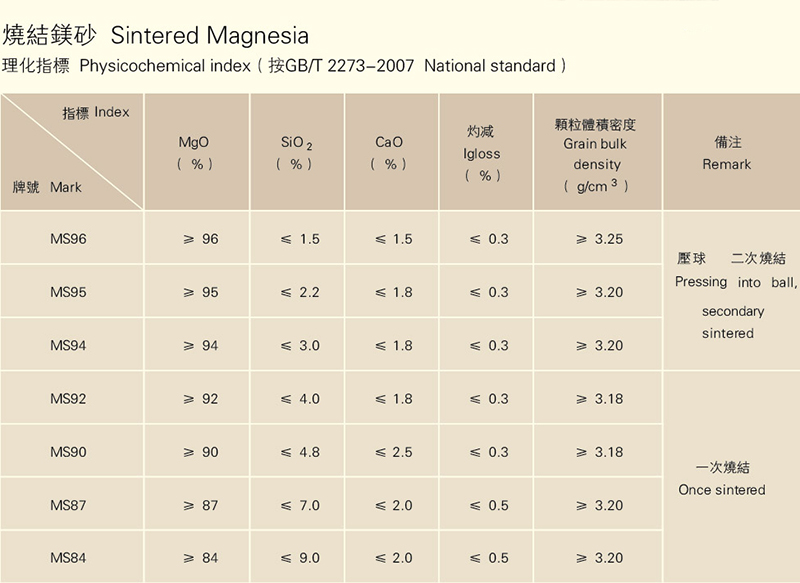Telephone:
+86 0417-3909999
Fax:
+86 0417-3909999
Contact:
Mr. Liu
website : en.ykblnc.com
company website:
www.ykblnc.com
E-mail:
bllzj888@163.com
address:
19-1 East, North Line, Yingda Road, Laobian District, Yingkou City, Liaoning Province

In addition to ordinary magnesia and mid-range magnesia, high-purity magnesia, large-magnesium magnesia, magnesia-calcium sand (high-calcium-magnesium sand), magnesium-silica sand (high-silica magnesia), and magnesium-calcium iron sand are often mentioned. These varieties are not completely separated. For example, some high-purity magnesia itself has a larger crystal size of periclase and can be counted as large crystalline magnesia.
The MgO content of ordinary magnesia is usually 87% to 95%, the particle bulk density is ≤3.30 g·cm-3, the SiO2 content is ≤2%, and Fe2O3<10%. The periclase crystals therein are 20 to 100 μm. Ordinary magnesia generally uses magnesite as a raw material. Due to the high content of impurities, a one-step calcination process is often used.
Mid-range magnesia, which is also called ball sand due to pressure ball formation, has a MgO content of 94% to 97% and a particle bulk density of ≥ 3.30 g·cm-3. Among them, the periclase crystals are 20 to 120 μm. High-quality magnesia is usually also made from magnesite, using a two-step calcination process.
High purity magnesia is relative to ordinary magnesia. It is often produced by a two-step calcination process using premium magnesite, magnesite concentrate or seawater Mg(OH)2. The requirements for the quality of high-purity magnesia are: 1 MgO ≥ 98% in the magnesia, and the SiO2 content is less than 0.4%, especially less than 0.1%. Due to the small amount of impurities, there is no silicate phase between the periclase crystals, and the direct combination is formed by dead burning at a high temperature. 2 The bulk density requirement is generally from 3.35 to 3.40 g·cm -3 or more. Bulk density is an important indicator for evaluating the quality of magnesia and can reflect the degree of sintering of magnesia. 3 The ratio of CaO/SiO2 of high purity high quality magnesia should not be less than 2. When the ratio of CaO/SiO2 is low, the low-melting phase is easily formed during the sintering of magnesia, forming a liquid film surrounding the magnesite grains, which hinders the formation of direct bonding. When the ratio is greater than 2, high-melting minerals such as C2S and C3S are formed. 5 Formation of large crystalline periclase. The magnesia crystal size in magnesia is 10μm, the quality of magnesia is generally good; 60μm is better; for high quality products it should be no less than 100μm; the best quality is 150~200μm.
The national standard GB 2273-1998 specifies the performance index of various grades of sintered magnesia for refractory materials. The ratio of CaO/SiO2 ratio of high grade sintered magnesia is not less than 2.
Magnesia (high-iron magnesia) is added to iron concentrate or iron scale by high-calcium magnesite (CaO<6%) and is used for electric furnace repair. The magnesia iron sand is russet brown, dark brown, massive, with a density of 3.58-3.61 g·cm-3, MgO of 68%-78%, Fe2O3 of 10% or more, and SiO2 of less than 5%. Among the magnesia iron sand, the magnesite is 67% to 72%, and the ferric acid dicalcium is 10% to 15%. The solution viscosity of dicalcium ferrite is very low, and the periclase can be well wetted, and the furnace bottom is easily sintered into a whole when used for sintering the hearth of the open hearth, and the life is greatly improved.